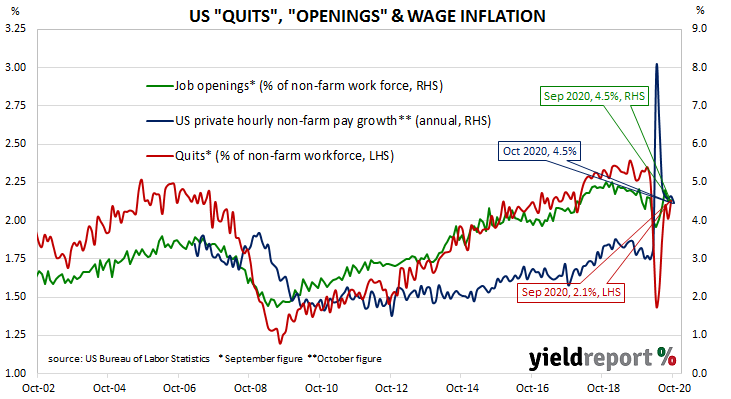Summary: US quit rate rises; job openings up, total separations down; policy makers to watch job openings “closely in early 2021”.
The number of US employees who quit their jobs as a percentage of total employment increased slowly but steadily after the GFC. It peaked in March 2019 and then tracked sideways until virus containment measures were introduced in March 2020. Quit rates plummeted as alternative employment opportunities rapidly dried up, followed by a sharp but partial recovery over the next few months. The trend has been more gradual recently.
Figures released as part of the most recent JOLTS report show the quit rate rose following a dip in the previous month. 2.1% of the non-farm workforce left their jobs voluntarily in September, an increase from August’s comparable figure of 2.0%. The largest source of additional quits arose from the “Other services”, “Professional and business services” and construction sectors while the “Retail trade” sector experienced fewer quits. Overall, the total number of quits for the month increased by 179,000 from August’s revised figure of 2.839 million to 3.018 million.

April’s non-farm payroll report indicated average hourly pay had spiked in that month, possibly the result of fewer lower-paid jobs relative to higher paying ones. Subsequent months’ figures then saw falls in average hourly pay, with a corresponding fall in the annual growth rate from 8.0% in April to 4.5% in October.
Total vacancies at the end of September increased by 84,000, or 1.3%, from August’s revised figure of 6.352 million to 6.436 million, driven by rises in the “Professional and business services”, “Transportation, warehousing, and utilities” and “Health care and social assistance” sectors. Fewer openings in the “Retail trade” and construction sectors provided some offsetting effects. Overall, 12 out of 18 sectors experienced more job openings than in the previous month.
Total separations during the same period decreased by a net 25,000 from August’s revised figure of 4.689 million to 4.664 million. The fall was led by the “Retail trade” and construction sectors, where there were respectively 64,000 fewer separations than in August while the “Other services” sector was the largest source of increased separations. Separations decreased in 7 of 18 sectors but they were collectively larger.

